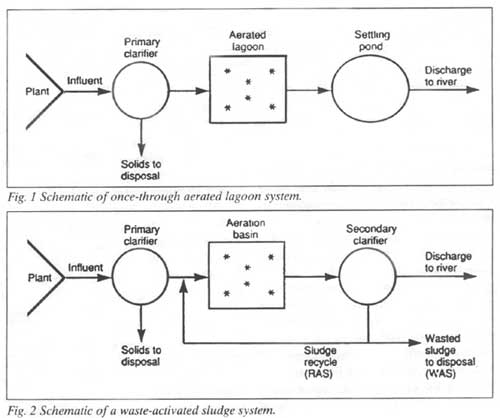Bioaugmentation
Aids
Wastewater Systems
operators face compliance levels that will seriously challenge the capabilities off their
plants. Bioaugmentation may be a viable "fix" until other solutions are available.
By Michael H. Foster, BS and G. Rob Whitemman, PhD
The
practice of utilizing specific microorganisms to carry out chemical transformations
has been applied in brewing, pharmaceutical and dairy industries. Microorganisms
also are critical components in the treatment of municipal and industrial
wastewaters.
In the treatment of wastewater, microorganisms
(mainly bacteria) use the soluble organic matter in the waste stream as
a food source. The bacteria consume the organic compounds and convert
them into carbon dioxide, water and energy to produce new cells. Ultimately,
the soluble pollutants are converted into insoluble biomass, which can
be removed mechanically from the waste stream and sent to disposal.
Wastewater treatment plants come in many types
and configurations, but this discussion will concentrate on aerobic treatment
for industrial systems.
Two of the most common general categories of aerobic
waste treatment systems found in industrial plants are the once-through
aerated lagoon system (Figure 1) and the activated sludge system (Figure
2).
In aerobic treatment systems, aerobic bacteria
utilize oxygen in the degradation of the organic compounds. For the system
to function, numerous parameters must be controlled. Among these parameters,
dissolved oxygen levels, pH and nutrient levels (ammonia and phosphorus)
are the most critical. Classical control strategies have focused on monitoring
and controlling the system parameters with little actual attention to
the microorganisms themselves.
The Bacteria
Bacteria (see Figure 3) are typically 1-2 um wide
and 2-20 um long. Due to the small size, shape or morphology can be examined only by using a high power microscope (x1000) and staining techniques. The Gram Stain is the basic criteria used to categorize groups of bacteria as either gram positive or gram negative, indicating a fundamental variation in cell-wall structure. Bacteria also are categorized using other criteria, such as:
• Use of oxygen in degrading organic matter
(uses oxygen only — aerobic;
can metabolize with or without oxygen —facultative; does not use oxygen — anaerobic);
• Use of carbon sources
(organic — heterotrophic;
carbon dioxide — autotrophic); and
• Optimum growth at different temperatures; (thermophiles — 55-75 deg. C;
mesophiles — 30-45 deg. C;
psychrophiles: obligate — 15-18 deg. C;
facultative — 25-30 deg. C).
Most aerobic wastewater treatment systems operate in the temperature range of 10-40 deg C and therefore contain mainly mesophilic bacteria. These include both the gram positive types, such as Bacillus, and the gram negative types, such as Pseudomonas.

Reprinted from Environmental Protection, October 1992